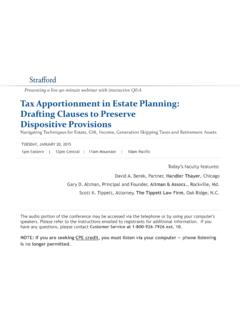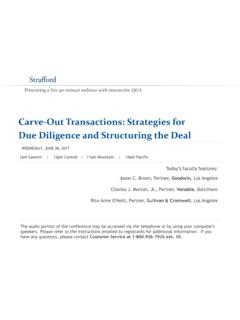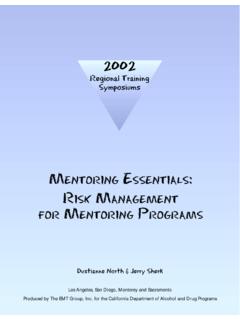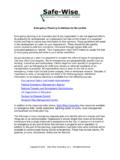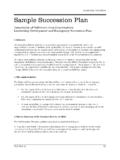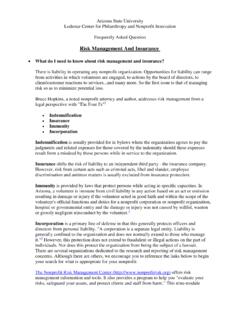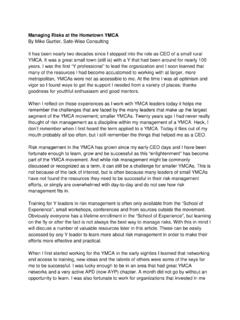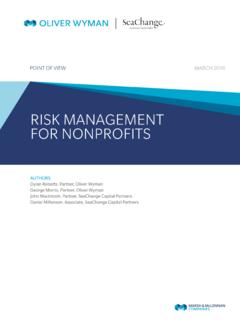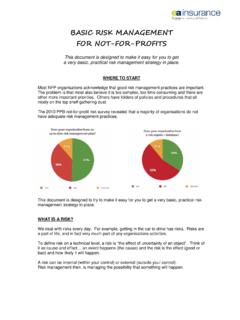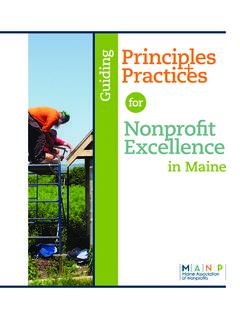Transcription of Risk Assessments for Non-Profit Organizations
1 Risk Assessments for Non-Profit OrganizationsIdentifying and Mitigating Unique risks to Improve Internal Controls and TransparencypresentsInternal Controls and TransparencypresentsToday's panel features:Ml i L kdHEti Di tNfitRikMtCtLb VA Live 110-Minute Teleconference/Webinar with Interactive Q&AMelanie Lockwood Herman, Executive Director, nonprofit Risk management Center, Leesburg, Gray, Director of Quality Assurance, Human Resources and Risk management , Doorways for Women and Families, Arlington, Broda, Founder and Managing Partner, Visage Solutions, LLC, Raleigh, Miller, Vice President and Lead Counselor, Non-Profit Practice, Oswald Companies, Cleveland, OhioWednesday, February 10, 2010 The conference begins at:1 pm Easternp12 pm Central11 am Mountain10 am PacificCLICK ON EACH FILE IN THE LEFT HAND COLUMN TO SEE INDIVIDUAL can access the audio portion of the conference on the telephone or by using your computer's refer to the dial in/ log in instructions emailed to no column is present: click Bookmarksor Pageson the left side of the window.
2 If no icons are present: Click View, select Navigational Panels, and chose either Bookmarksor you need assistance or to register for the audio portion, please call Strafford customer service at 800-926-7926 ext. 10 For CLE purposes, please let us know how many people are listening at your location by closing the notification box and typing in the chat box your company name and the number of attendees. Then click the blue icon beside the box to Assessments For nonprofit Organizations WebinarFeb. 10, 2010 Melanie Lockwood HermanKathy MillerNonprofit Risk management CenterOswald GrayBob BrodaDoorways for Women and FamiliesVisage Solutions, s Program Background Concepts, slides 3 and 4 (Melanie Lockwood Herman) Aspects Of The Risk assessment , slides 5 through 16 (Melanie Lockwood Herman)Lockwood Herman) Risk assessment Experiences At One nonprofit , slides 17 through 30 (Melanie Gray) Using Insurance To Complement A Risk- assessment Process slides Using Insurance To Complement A Risk- assessment Process, slides 31 through 45 (Kathy Miller) Internal Controls At Nonprofits: Best Practices Vs.
3 Required Practices, slides 46 through 65 (Bob Broda)slides 46 through 65 (Bob Broda)2 Background Concepts3 Risk assessment Background Is the demand for risk Assessments growing? Possible reasons why: Stakeholder demands/expectations for greater effectiveness and ffi iefficiency Cache of the risk assessment discipline and terminology ( 15 minutes of fame ) Post-incident panic/focus4 Aspects Of The Risk Assessment5 Reasons To Conduct A RiskReasons To Conduct A Risk assessment Formal Board requirement Board requirement Funder requirement Informal Sleep more peacefully (leader confidence) Position nonprofit for long-term success Protect mission66 Types Of Risk Assessments Terminology is widely used and may be used to described a wide range of activities, such as:range of activities, such as.
4 A facility inspection An audit of internal control weaknesses The implementation of new risk management policies77 Types Of Risk Assessments (Cont.) To some degree, what constitutes a risk assessment will depend on who conducts it Common providers of risk assessment services include: Insurance agents and brokers Audit firms Independent consulting firms Independent risk management consulting firms88 What Is A Risk assessment ? A risk assessment is the process of examining the exposures an organization faces in order to identify recommended steps fororganization faces in order to identify recommended steps for strengthening the organization s future loss control and risk management strategies and activities nonprofit Risk management nonprofit Risk management Center99 Self- assessment Many Organizations rely solely on insiders (staff and volunteers)
5 To undertake a risk assessment of their exposures The upside of this approach is that it requires personnel in the nonprofit to learn about a wide range of risks and consider responsive strategies Conducting a self- assessment is an excellent first step in broadening awareness about risk and risk management in your organization The two potential downsides are that: (1) Most nonprofits do not have the luxury of assigning the task of a risk assessment to busy personnel who wear multiple hats, and ypp,(2) An assessment conducted by insiders may not be as effective in spotting the wide range of issues facing the organization 1010 Broker Or Carrier-Conducted Risk assessment Many nonprofits turn to their insurance providers agents, brokers and carriersfor assistance conducting a risk assessment (or if not a true riskcarriers for assistance conducting a risk assessment (or if not a true risk assessment , a site visit/inspection with follow-up to do items noted) Thh thi til tihifitih l f lid Through these existing relationships, a nonprofit may receive helpful guidance on key insurable exposures.)
6 The broker or carrier representative may be able to offer specific advice that will help the nonprofit keep premiums at a minimum and coverage options open Many brokers and carriers offer riskminimum and coverage options open. Many brokers and carriers offer risk assessment services for free, as part of the continuum of support available to insureds. In other instances a broker may charge a fee to conduct a risk assessmentassessment1111 Broker Or Carrier-ConductedBroker Or Carrier-Conducted Risk assessment (Cont.) It is important to keep in mind that brokers and carriers that offer risk Assessments are likely to approach these assignments from a loss prevention perspective (focusing on insurable risks ), rather than a broader, enterprise risk management perspective Note:In the nonprofit Risk management Center s view, it does notNote: In the nonprofit Risk management Center s view, it does not make sense for a nonprofit to receive risk assessment services from a competitor to its current insurance provider.
7 If you are unhappy with the services provided by your broker but want to receive a free risk assessment conducted by a broker, you should first select a new firm and then work with that new broker on the risk assessment12 Independent Risk assessment An independent risk assessment differs from the other approaches in three important respects: First, the assessment is conducted by a consultant who does notFirst, the assessment is conducted by a consultant who does not sell insurance or represent insurance carriers Second, because it is separate from any insurance arrangement, an independent assessment is generally broader in scope, focusing onindependent assessment is generally broader in scope, focusing on uninsurable as well as insurable risks Third, and perhaps most importantly, an independent risk assessment provides the client organization with a link to a risk assess ep ov dese c eo gaa o wao a smanagement expert to whom they can turn with difficult risk management questions and dilemmas1313 Independent Risk assessment (Cont.)
8 Some nonprofit leaders may be more likely to share the reality of theSome nonprofit leaders may be more likely to share the reality of the organization s operations ( examples of policies that aren t being followed) with a consultant who is independent of the insurance transaction Independent risk Assessments are provided on a fee-basis. The cost of the assessment should be confirmed before work begins, and will range from a low of $2,500 to a high of $25,000 depending on thescopeof the assessmentlow of $2,500 to a high of $25,000 depending on the scopeof the assessment and the client s needs. An independent risk assessment may include an insurance coverage review the careful analysis of the adequacy of a nonprofit s insurance program in light of the exposures identified in the risk assessment .
9 Some brokers and carriers may be willing to contribute to covering the cost of an independent assessment1414Ri k At Ri dRisk assessment Reminders Be honest about the reasons for conducting a risk assessment Remember that a risk assessment is not a substitute for an ongoing risk management program and the commitment to integrating RM into gpgggplanning and operations Prepare for surprising resultsPrepare for surprising results Adopt a realistic strategy for follow-up1515 Risk assessment Reminders (Cont.) Remember the wisdom of crowds when looking for insight on the Remember the wisdom of crowds when looking for insight on the nonprofit s risk. There is no single leader who can tell the entire storyUthi kttit tli it idttth Use the risk assessment as an opportunity to solicit ideas to strengthen risk management policies and programs1616Ri k AEiA ORisk assessment Experiences At One Nonprofit17 Once The Risk assessment IsOnce The Risk assessment Is Complete You have your organization s risk on paper Whom do you share the risk assessment with first?
10 You will likely feel exposed ; it is normal to feel this way! How do you move forward?1818 Successfully Move From AssessmentSuccessfully Move From assessment To Action1 Ghihli the right people if you have a complete and sufficient identification of if you focused on the right what you ve learned in your risk prepared to manage risk over the long term1919 Getting StartedGetting Started Find a risk management champion in your organization . This is the individual who introduces and the supports RMA, and can assist in securing funding, resources and availability of key personnel Champion must carve weekly time on the calendar to address risk Get the right people together to have aregulardialogueGet the right people together to have a regulardialogue Many people don t know about RM or speak the language.
